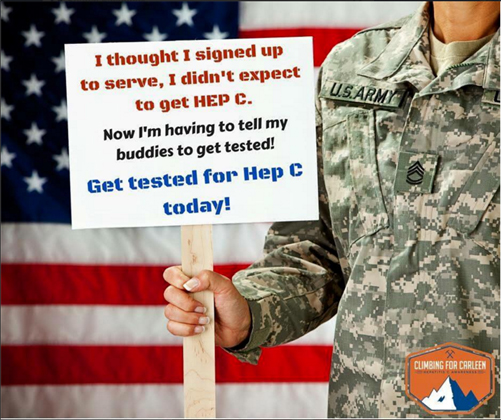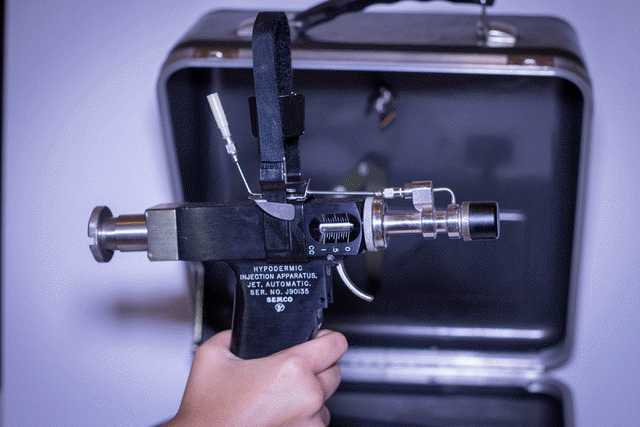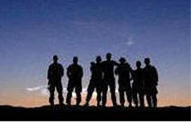
Morbidity and Mortality Weekly Report (MMWR)
General Recommendations on Immunization
Recommendations of the Advisory Committee on Immunization Practices (ACIP)
Please
note: An erratum has been
published for this article. To view
the erratum, please click
here.
Recommendations and Reports
January 28, 2011 /
60(RR02);1-60
Jet Injections
Jet injectors are needle-free devices that pressurize liquid medication, forcing it through a nozzle orifice into a narrow stream capable of penetrating skin to deliver a drug or vaccine into intradermal, subcutaneous, or intramuscular tissues (101,102). Jet injectors prevent needle-stick injuries to health-care providers (86) and can overcome improper, unsterile reuse and other drawbacks of needles and syringes in developing countries (87,103--104). Immune responses generated by jet injectors against both attenuated and inactivated viral and bacterial antigens are usually equivalent to, and occasionally greater than, immune responses induced by needle injection. However, local reactions or injuries are sometimes more frequent on delivery of vaccine by jet injectors compared with needle injection, depending on the inherent irritability of the vaccine and operator technique (102). Jet injectors that use the same nozzle for consecutive injections without intervening sterilization were used in mass vaccination campaigns from the 1950s through the 1990s (102); however, these were found to be unsafe because of the possibility of bloodborne pathogen transmission (105--108) and should not be used. A new generation of jet injectors with disposable cartridges and syringes has been developed since the 1990s. With a new, sterile dose chamber and nozzle for each patient and correct use, these devices do not have the same safety concerns as multiple-use nozzle jet injectors. Several of the newer devices have been approved by FDA for sale in the United States (102).
http://www.cdc.gov/mmwr/preview/mmwrhtml/rr6002a1.htm
Note to reader- CDC is misinformed again of the safety of a new generation of jet injectors with disposable cartridges. Please read how 8% of these devices tested failed, capable of transmitting hepatitis c.
2008 CDC- Jetguns (PCNIF) Fail Safety Test
References:
87 Drucker E, Alcabes PG, Marx PA. The injection century: massive unsterile injections and the emergence of human pathogens. Lancet 2001;358:1989--92.
101 Hingson RA, Davis HS, Rosen M. Historical development of jet injection and envisioned uses in mass immunization and mass therapy based upon two decades' experience. Mil Med 1963;128:516--24.
102 Weniger BG, Papania MJ. Alternative vaccine delivery methods [Chapter 61]. In: Plotkin SA, Orenstein WA, Offit PA, eds. Vaccines, 5th ed. China: Saunders/Elsevier;2008;135
103 Simonsen L, Kane A, Lloyd J, Zaffran M, Kane M. Unsafe injections in the developing world and transmission of bloodborne pathogens: a review. Bull World Health Organ 1999;77:789--800. 104 Kane A, Lloyd J, Zaffran M, Simonsen L, Kane M. Transmission of hepatitis B, hepatitis C and human immunodeficiency viruses through unsafe injections in the developing world: model-based regional estimates. Bull World Health Organ 1999;77:801--7.
105 CDC. Hepatitis B associated with jet gun injection---California. MMWR 1986;35:373--6.106 Canter J, Mackey K, Good LS, et al. Outbreak of hepatitis B associated with jet injections in a weight reduction clinic. Arch Intern Med 1990;150:1923--7.
107 Hoffman PN, Abuknesha RA, Andrews NJ, Samuel D, Lloyd JS. Model to assess the infection potential of jet injectors used in mass immunization. Vaccine 2001;19:4020--7.
108 Kelly K, Loskutov A, Zehrung D, et al. Preventing contamination between injections with multiple-use nozzle needle-free injectors: A safety trial. Vaccine 2008;26:1344--52.
|
|






